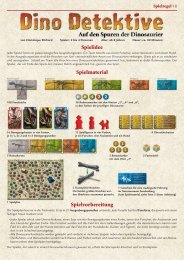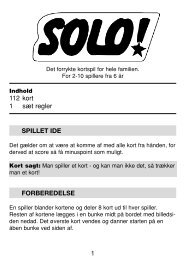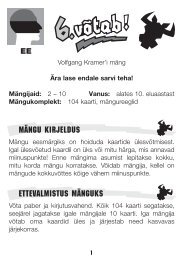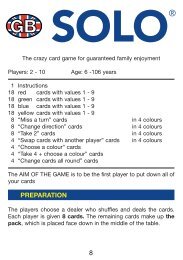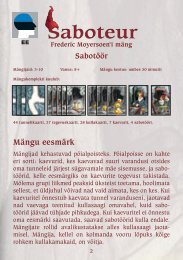Spielmaterial Spielziel Spielvorbereitung - AMIGO Spiel + Freizeit ...
Spielmaterial Spielziel Spielvorbereitung - AMIGO Spiel + Freizeit ...
Spielmaterial Spielziel Spielvorbereitung - AMIGO Spiel + Freizeit ...
You also want an ePaper? Increase the reach of your titles
YUMPU automatically turns print PDFs into web optimized ePapers that Google loves.
Exception to rule no. 5:<br />
If a player can only place one of his two tiles or neither of them, he places the tiles that he has not used in front of him<br />
on the table, face down, and saves them for his next turn. If he has two or more tiles in front of him on the table at the<br />
beginning of his next turn, he checks if he can place one or more of them on the board. If this is the case, he may not draw<br />
a new tile, but must use the tiles left over from the last turn instead. But if he only has a single tile in front of him on the<br />
table, or if he cannot place any of the two or more tiles, he draws one tile out of the bag. If he is now able to place a tile<br />
on the board, he may use all his tiles (even if there are more than two).<br />
Option A: He places<br />
the tiles so that he can<br />
note an 11 and a<br />
cross in the “x2”<br />
column. He does not<br />
earn any points for<br />
the tile.<br />
There are nearly always several ways of putting the tiles on the board. It depends on the<br />
course of the game which option is the better one.<br />
Since it is always preferable to note points evenly, option B would be the better one for<br />
Andrew. So he notes:<br />
Please observe the following rules for scoring:<br />
Betty only draws one tile – it’s a . She now has<br />
two tiles that she can place on the board. She<br />
uses both tiles but does not earn any points,<br />
because the total of the line is only 9.<br />
Andrew draws a and a . He now has several options.<br />
Scoring<br />
1. Each player notes the score for the tiles he has just placed on the board on his own sheet.<br />
2. Fill in your scoring sheet from top to bottom. Do not miss any lines!<br />
Or option B:<br />
He places the tiles so<br />
that he earns a 10<br />
and a 12 as well as a<br />
cross in the “x2”.<br />
3. For a line with a total of 10, you get 1 point; for 11, you get 2 points; and for 12, you get 4 points.<br />
4. Note the achieved points on the scoring sheet in the corresponding column.<br />
5. It is possible to form lines with a total of less than 10, but they do not score any points.<br />
6. If a player places a tile on a light-coloured square on the board (= double score), he must form a line of 10, 11 or 12,<br />
either with the tile placed on the light-coloured square or both tiles together. On the pad, he notes a cross in the<br />
next free box of the “x2” column. It is possible to note two “x2” crosses in a single turn – these are noted one<br />
beneath the other.<br />
Note: At the beginning, you place a tile on the red square. In this case, you may also note a cross in the “x2” column<br />
if you form a line with at least 10 points.<br />
7<br />
Betty<br />
Andrew




